
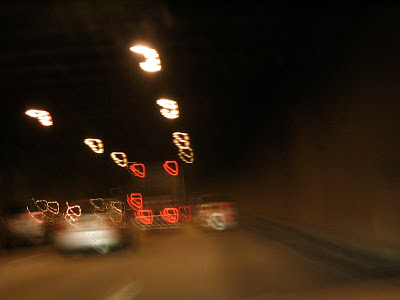 This was the quotation from the Lord Mayor of Copenhagen this past week in his defense of advocating for the building of a DKK (that’s the ISO code for the money used in Denmark) 27 Billion tunnel running 12 kilometers/7.5 miles from northeast of the city center (The North Harbor/“Nordhavn”) east through the island of Amager around to the southwest where it would join with the country’s E20 motorway which heads both east to the bridge to Sweden and west to the bridge over to the island of Funen (“Fyn” in Danish) and then to Jutland.
This was the quotation from the Lord Mayor of Copenhagen this past week in his defense of advocating for the building of a DKK (that’s the ISO code for the money used in Denmark) 27 Billion tunnel running 12 kilometers/7.5 miles from northeast of the city center (The North Harbor/“Nordhavn”) east through the island of Amager around to the southwest where it would join with the country’s E20 motorway which heads both east to the bridge to Sweden and west to the bridge over to the island of Funen (“Fyn” in Danish) and then to Jutland.
YES, TWENTY-SEVEN-BILLION-WITH-A-"B" DANISH KRONER!
(And the cost could be even higher)
Even if it is paid out using coins made with holes and/or embossed hearts or bills/notes currently printed with pictures of pagan relics (and ironically, bridges) on them (they used to have moths, sparrows and Hans Christian Andersen) that's a lot of real money; At current exchange rates that works out to 4.6 Billion U.S. Dollars or 3.6 Billion Euros!
Let's put these costs in some perpective:
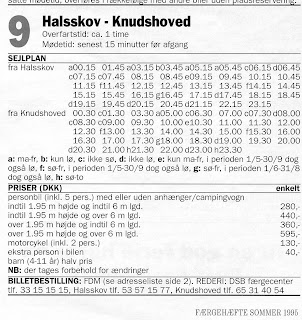 |
| 1995 Storbælt Ferry Fares |
(The fixed-link to Germany is more controversial because a route from Sweden through Denmark to Germany has already been created by using the two bridges plus Jutland, but it certainly has a potential market)
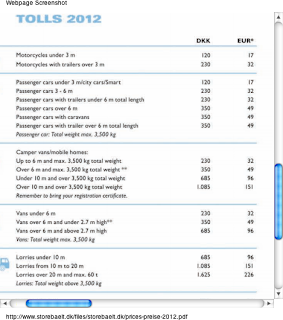 |
| 2012 Storbælt Bridge Tolls |
When looking at these project costs, please keep in mind that these facilities charge a toll that is comparable to the fare of the ferries they replaced or still partially compete with; which is certainly not the case for similar projects in other parts of the world.
So this "Eastern Bypass" (the new name intended to attract funding from the national government) is a project that will cost 70% of what the fixed-link bridge projects did, but offers Copenhagen no parallel capacity for rail (which actually does need more capacity through the city center), and doesn't do anything for the nation or the region, or the EU as a whole. It merely "promises" to remove congestion from the city center.
Congestion, it turns out, is an inevitable consequence when the private sector produces an unlimited number of vehicles and expects the public sector to spend limited resources to build an unlimited amount of space for them to run on. ---Gordon Price, Transport Planner and former City Councillor, Vancouver, British Columbia, Canada
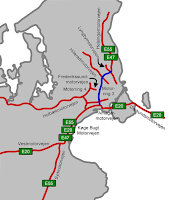 |
| Current Motorway Network around Copenhagen |
(We'll discuss the false promise of ring roads and by-passes, as well as tunneling projects cost in later posts)
Or is something-else afoot here? Is Copenhagen about to "pee in its pants to keep warm"?
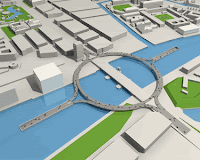 |
| Interchange proposal for Long Bridge |
 He goes on, in the original Berlingske News Bureau article on which the Copenhagen Post article is based, to say "Så derfor skal vi også sørge for, at trafikken kan afvikles ordentligt, så vi ikke spilder tid, når folk sidder i kø," or, and kind reader you are free to contribute a better translation in the comments section, "We therefore must ensure that traffic can flow properly so we don't waste the time (of people who chose to travel by private car) when they sit in queues".
He goes on, in the original Berlingske News Bureau article on which the Copenhagen Post article is based, to say "Så derfor skal vi også sørge for, at trafikken kan afvikles ordentligt, så vi ikke spilder tid, når folk sidder i kø," or, and kind reader you are free to contribute a better translation in the comments section, "We therefore must ensure that traffic can flow properly so we don't waste the time (of people who chose to travel by private car) when they sit in queues". In other words, the top official of the city that had promised to be the first carbon-free city on Earth in the 21st century has just also promised that his city will, because of course it must, don't you know, accomodate and move more cars.




